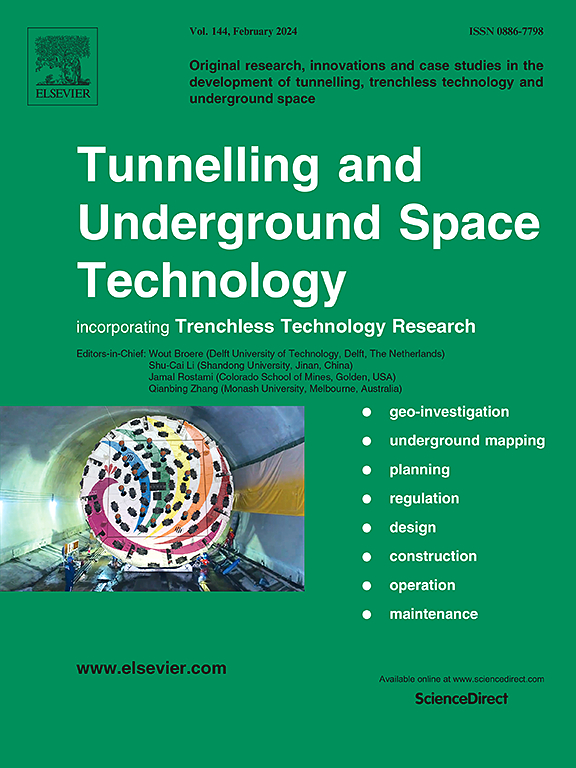Analytical solutions for discharge and hydraulic head of three-dimensional underground caverns in coastal areas
IF 6.7
1区 工程技术
Q1 CONSTRUCTION & BUILDING TECHNOLOGY
引用次数: 0
Abstract
The determination of discharge and hydraulic head of underground caverns is a crucial aspect for their engineering construction. The boundary of aquifer should be bounded for the calculation of seepage field of underground caverns in coastal areas. Therefore, analytical solutions for discharge and hydraulic head of underground caverns with square arch cross-section in a three-dimensional(3D) bounded unconfined aquifer are presented in this paper. Fourier series expansion and Laplace transform are used to obtain a point sink solution. Solutions of discharge and hydraulic head caused by multiple caverns with square arch cross-section in the 3D bounded unconfined aquifer are obtained by integrating the point sink solution in cavern domain which includes cavern cavity, cavern surface and cavern outline (C-S-O integration method). The accuracy of the point sink solution and the cuboid cavern solution is verified by comparing with numerical solutions obtained by COMSOL. The comparison shows that the analytical solutions agree well with numerical solutions. The effects of vertical hydraulic conductivity and specific yield on cavern discharge and hydraulic head are investigated. Treatment methods for actual projects which usually involve the construction of multiple caverns with square arch cross-section, and the long axis of the cavern forms an angle θ with the horizontal axis are presented. A more simplified integration method (S-O), which includes only cavern surface and cavern outline, is proposed, and compared with the results of C-S-O, which indicates that the simplified approach achieves comparable accuracy. The study offers theoretical reference for the prediction of discharge and groundwater level during the excavation and operation of underground caverns.
沿海地区三维地下洞室流量及水头解析解
地下洞室流量和水头的确定是洞室工程建设的关键环节。沿海地区地下洞室渗流场的计算需要确定含水层边界。为此,本文给出了三维有界无承压含水层中方拱断面地下洞室流量和水头的解析解。利用傅里叶级数展开和拉普拉斯变换得到了一个点汇聚解。采用C-S-O积分法,对包括洞腔、洞面和洞廓在内的洞域点汇解进行积分,得到了三维有界无承压含水层中多个方拱断面洞室引起的流量和水头解。通过与COMSOL数值解的比较,验证了点汇解和长方体洞室解的精度。结果表明,解析解与数值解吻合较好。研究了垂直导水率和比屈服对洞室流量和水头的影响。针对实际工程中多洞室、洞室长轴与水平轴成角θ的方拱断面多洞室的施工,提出了相应的处理方法。提出了一种更简化的只包括洞室表面和洞室轮廓的积分方法(S-O),并与C-S-O的结果进行了比较,结果表明简化方法具有相当的精度。研究结果为地下洞室开挖及运行过程中流量及地下水位的预测提供了理论参考。
本文章由计算机程序翻译,如有差异,请以英文原文为准。
求助全文
约1分钟内获得全文
求助全文
来源期刊

Tunnelling and Underground Space Technology
工程技术-工程:土木
CiteScore
11.90
自引率
18.80%
发文量
454
审稿时长
10.8 months
期刊介绍:
Tunnelling and Underground Space Technology is an international journal which publishes authoritative articles encompassing the development of innovative uses of underground space and the results of high quality research into improved, more cost-effective techniques for the planning, geo-investigation, design, construction, operation and maintenance of underground and earth-sheltered structures. The journal provides an effective vehicle for the improved worldwide exchange of information on developments in underground technology - and the experience gained from its use - and is strongly committed to publishing papers on the interdisciplinary aspects of creating, planning, and regulating underground space.
 求助内容:
求助内容: 应助结果提醒方式:
应助结果提醒方式:


